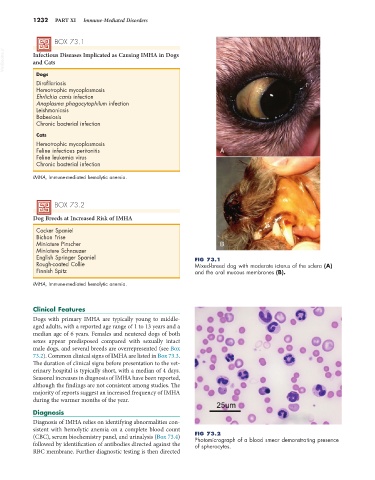Page 1260 - Small Animal Internal Medicine, 6th Edition
P. 1260
1232 PART XI Immune-Mediated Disorders
BOX 73.1
VetBooks.ir Infectious Diseases Implicated as Causing IMHA in Dogs
and Cats
Dogs
Dirofilariasis
Hemotrophic mycoplasmosis
Ehrlichia canis infection
Anaplasma phagocytophilum infection
Leishmaniasis
Babesiosis
Chronic bacterial infection
Cats
Hemotrophic mycoplasmosis
Feline infectious peritonitis A
Feline leukemia virus
Chronic bacterial infection
IMHA, Immune-mediated hemolytic anemia.
BOX 73.2
Dog Breeds at Increased Risk of IMHA
Cocker Spaniel
Bichon Frise
Miniature Pinscher B
Miniature Schnauzer
English Springer Spaniel FIG 73.1
Rough-coated Collie Mixed-breed dog with moderate icterus of the sclera (A)
Finnish Spitz and the oral mucous membranes (B).
IMHA, Immune-mediated hemolytic anemia.
Clinical Features
Dogs with primary IMHA are typically young to middle-
aged adults, with a reported age range of 1 to 13 years and a
median age of 6 years. Females and neutered dogs of both
sexes appear predisposed compared with sexually intact
male dogs, and several breeds are overrepresented (see Box
73.2). Common clinical signs of IMHA are listed in Box 73.3.
The duration of clinical signs before presentation to the vet-
erinary hospital is typically short, with a median of 4 days.
Seasonal increases in diagnosis of IMHA have been reported,
although the findings are not consistent among studies. The
majority of reports suggest an increased frequency of IMHA
during the warmer months of the year.
Diagnosis
Diagnosis of IMHA relies on identifying abnormalities con-
sistent with hemolytic anemia on a complete blood count
(CBC), serum biochemistry panel, and urinalysis (Box 73.4) FIG 73.2
Photomicrograph of a blood smear demonstrating presence
followed by identification of antibodies directed against the of spherocytes.
RBC membrane. Further diagnostic testing is then directed

